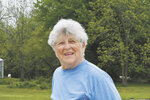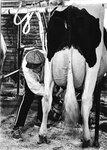

LANSING, Iowa — When Patsy Kerndt was 10 years old, she would sit on a wooden stool with a bucket between her legs, milking cows by hand. Each evening, Kerndt would perform the task on two to three of her family’s cows after school.
Her family tried to get her to drive tractor, but that did not go well.
“I just would get petrified, and so I said, ‘I’ll do chores ... don’t ask me to run machinery,’” Kerndt said.
Kerndt has seen many changes in dairy from her beginnings of hand milking in the 1940s to milking units and from carrying canned milk to pipelines and bulk tanks. Kerndt has also survived personal tragedy, carrying on the family dairy farm after her husband’s early death for the sake of their teenage son. Her farm was sustained through the farm crisis of the 1980s and the fluctuating milk prices of her later farming years.
Kerndt continued milking cows as an adult in the evenings after her job in town. She was even milking cows the day after she returned from her honeymoon.
“I just went from one farm to the next,” Kerndt said.
Kerndt milked in four different barns across her career. Her childhood farm had 30-40 cows and was about 540 acres. In addition to dairy cows, they also raised 75-100 beef animals, chickens and pigs. Though they farmed with tractors, Kerndt remembers leading a horse back and forth to power the trip fork for transporting loose hay to the mow.
When she was 12, her dad built a new barn. They christened it with barn dances.
“Everybody had a good time,” Kernt said. “It was good old-fashioned barn dancing.“
In the new barn, they used floor bucket milking units. Despite the advances in technology, there still was no barn cleaner, so all manure had to be hand pitched into the manure spreader.
There was no pipeline, so milk was carried to 10-gallon cans in the milk house and were cooled on one side of the cows’ water tank.
“In the winter months, when the milkman couldn’t get in, then ... (we had) to haul the milk out to the road where he could get them,” Kerndt said. “That went on for a number of years before we got a bulk tank.”
After she married Donnie Kerndt in 1961, she worked in her third barn and third milking setup.
Donnie’s family used Surge bucket milkers. Their barn was about 140 feet long and had one long row of cows. Kerndt recalls having to hurry to carry the milk the length of the barn to the milk house before another cow’s milker was done. Eventually, they upgraded their barn with a transfer system, making the long carry no longer necessary.
Even after having children, Kerndt continued to milk.
“I milked right up to the day I delivered with both of them,” Kerndt said. “It was good exercise for me. I guess I just loved being out there, being with the animals.”
Her eldest son was entertained in a playpen in the barn while she milked. For her youngest, she hooked up an intercom system between the barn and the playpen.
“The intercom was right above (the baby), so I could hear if she was fussing, or being naughty or doing something,” Kerndt said.
In 1971, the Kerndts built their last barn, where they milked 60 cows. Kerndt said Donnie wanted a stanchion so that he could show off the cows. The new barn was complete with a pipeline to the bulk tank.
“After working in that old barn down there carrying that milk, I thought this is really easy,” Kerndt said.
Donnie was an early adopter of A.I., starting before they were married.
The Kerndts sold occasional cows on dairy sales and leased bulls to local farms. After the bulls returned, they were sold to the sales barn.
In 1976, tragedy struck when Donnie was diagnosed with cancer. The couple sold the milking herd Dec. 11, 1976, and Donnie passed away Jan. 1, 1977.
Their children were ages 15 and 3 at the time, so the Kerndts retained around 25 heifers so that Brad, the oldest, could have a chance to farm.
“Donnie said, ‘Are you sure you want to do this?’” Kerndt said. “I said, ‘Well, it’s the only way Brad’s going to get a chance … If we sell (all the heifers) how is he ever going to get back into farming?’”
During Brad’s senior year, they started milking their heifers. Kerndt’s prior active involvement on the farm made it easier for the single mom to farm with her young son.
“It was stressful,” Kerndt said. “I (had) farmed with Donnie, so I knew everything that was going on. It wasn’t like I was working off the farm or anything. I was beside him all the time. ... I did the book work, so I knew what was going on there, and I just learned to ask questions.”
Kerndt dairy farmed with Brad, doing chores for him for over 40 years.
Over the years, Kerndt has seen variation in milk prices and the economics of dairy farming. She said in the early 1970s it was “a pretty good living” but in the 1980s the prices and interest were both bad. She also experienced the fluctuating milk prices.
“It got hard towards the end,” Kerndt said. “How to budget, how to make ends meet, because you couldn’t depend upon that milk price.”
Kerndt continued milking until the age of 85.
“After I quit milking, then I went to pot because I didn’t have anything to do,” Kerndt said.
The Kerndts sold close to 100 animals at their herd dispersal in 2021 although Brad continues to raise some heifers and flush them.
“I hated to see them go,” Kerndt said.
Comments
No comments on this item Please log in to comment by clicking here